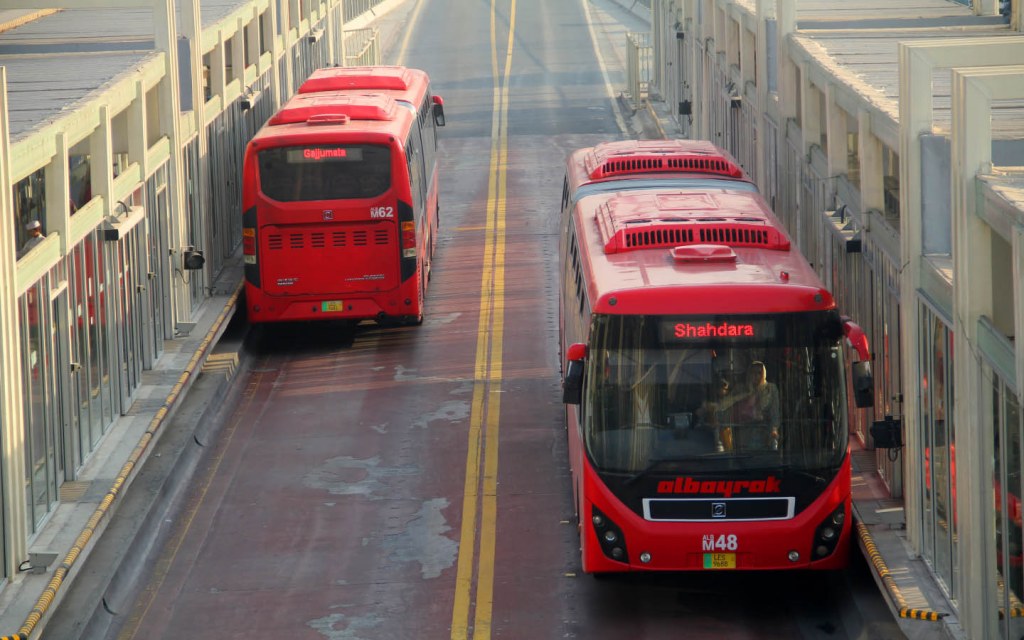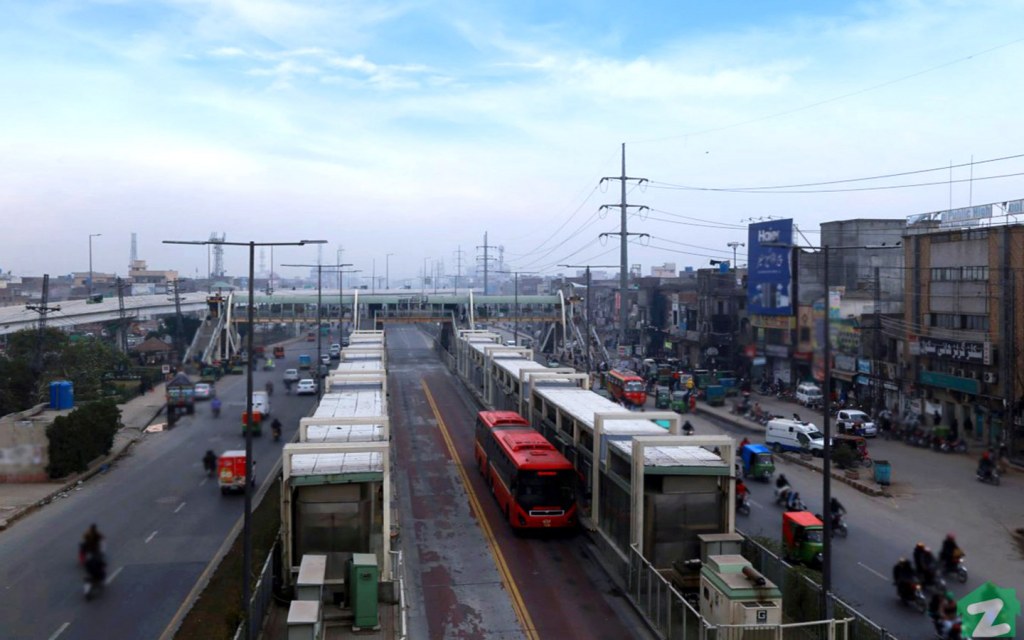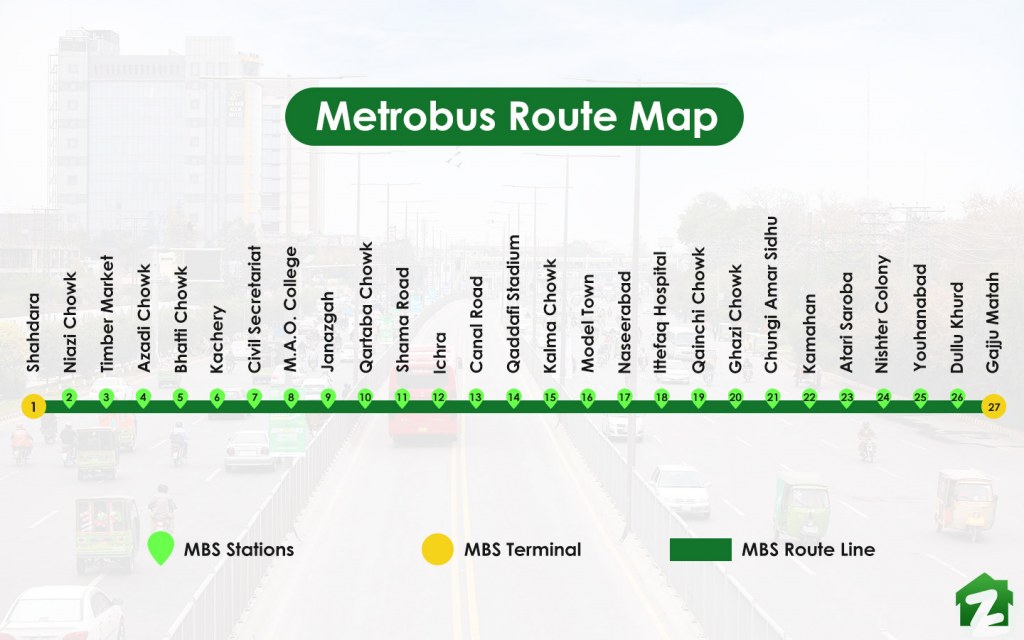Update: (Oct. 07, 2021): In a recent development, Chief Minister of Punjab Usman Buzdar inaugurated a fleet of 64 new environmentally-friendly buses for the Metrobus system in Lahore. A ceremony was held at the metro bus depot at Ferozpur Road to mark the arrival of the new buses.
While addressing the launch ceremony, CM Buzdar said the provincial government was doing everything in its capacity to resolve the transportation issues in Lahore by upgrading the infrastructure of the city.
He also praised the efforts undertaken by the Lahore Masstransit Authority (LMA) for improvising the mass transit system and providing state-of-the-art and reliable transportation facilities to around 125,000 passengers in the city on daily basis.
Lahore, the liveliest city of Punjab as well as its administrative capital, has undergone rapid development in recent years. The metropolis offers a delightful mix of ancient history and modern infrastructure. Azadi Chowk Metro Station, situated against the magnificent backdrop of Badshahi Masjid (as shown in the cover above), is a perfect example in this regard. Lahore also witnessed the construction of mega projects like Ring Road and Kalma Chowk Flyover that have helped ease the flow of traffic, thereby reducing congestion on the roads. Another major initiative that was recently introduced in the city to upgrade the public transport system is Lahore Metrobus, which is widely known as Pakistan’s first Bus Rapid Transit (BRT) service.
Which Authority Operates Lahore Metrobus?

Lahore Metrobus isn’t operated by Lahore Transport Company (LTC), instead, the Punjab Masstransit Authority (PMA), which is one of the provincial government’s regulatory authorities, is directly responsible for the operation and maintenance of Metro Bus System in Lahore. It is one of the most prominent modes of transportation available in the city.
Not only did the new Metro Bus project breathe new life into a more or less defunct public transport system in Lahore, but also appreciably raised the bar for improvement in other major cities.
History and Construction of Lahore Metrobus System

Following the example of Istanbul Metrobus System in Turkey, the government of Punjab, in collaboration with the federal government, proposed the very first BRT system of Pakistan in Lahore. The construction of the Lahore Metrobus project began in 2012; it was carried out in different phases and packages were handed over to various contractors for the provision of various types of raw materials used in construction.
A whopping amount of around PKR 29 billion had been spent on the development of Lahore’s Metro Bus System (LMBS) by the Traffic Engineering and Planning Agency (TEPA), which is a subsidiary of the Lahore Development Authority (LDA). The most awaited launch of Lahore’s Metro Bus took place in February 2014; since then, this transportation system has been providing state-of-the-art facilities to the people of Lahore.
Design, Features and Infrastructure
Keeping in view the criteria set by the Institute for Transportation and Development Policy, the design and infrastructure for Lahore’s Metro Bus has been equipped with all the latest features. The system boasts automated off-board fare collection. Metro Bus Stations across Lahore also have well-designed sign-boards that allow people to conveniently find their way inside the stations.
During peak hours, a bus usually leaves the station after every two minutes in order to keep the vehicles from getting overcrowded with commuters. Moreover, Metro Bus Stations in Lahore also include parking spaces for vehicles like cars, motorbikes and bicycles for the convenience of commuters. Since Metro Buses in Lahore run on totally separate corridors with elevated rotaries that are not usually hindered by the movement of the city’s traffic, they have dramatically cut down the time it takes to travel between the two points in Lahore.
Route Map of Lahore Metrobus

The Lahore Metro Bus is currently based on a fleet of over 60 buses, each of which extends to over 18 metres in length. Starting from Gajju Matah, going all the way to Shahdara via Ferozpur Road, which is Lahore’s main artery, these buses run along a single route of 27 kilometres with 27 metro stations.
How Important Is Feeder Bus Network For Passengers Using The Lahore Metrobus System?
The route of Metro Bus Lahore is not easily accessible from many areas in Lahore as it is a straight corridor, which is why Punjab Masstransit Authority (PMA) has introduced a network of feeder buses. The routes of these feeder buses cover many different parts of Lahore and often intersect each other, ensuring hassle-free commutes to the passengers of the Lahore Metrobus. Let’s take a look at all of the feeder bus routes.
| Route No. | Route |
| FR-1 | Railway Station to Bhatti Chowk |
| FR-2 | Bhatti Chowk to Samanabad Morr |
| FR-3 | Railway Station to Rana Town |
| FR-4 | R.A. Bazar to Chungi Amar Sidhu |
| FR-5 | Shadbagh Underpass to Bhatti Chowk |
| FR-6 | Babu Sabu to Raj Garh Chowk |
| FR-7 | Bagrian to Chungi Amar Sidhu |
| FR-8 | Canal Road to Daewoo Terminal |
| FR-9 | Railway Station to Sham Nagar |
| FR-10 | Multan Chungi to Qartaba Chowk |
| FR-11 | Babu Sabu to Gulberg Main Market |
| FR-12 | R.A. Bazar to Civil Secretariat |
| FR-13 | Bagrian to Kalma Chowk |
| FR-14 | R.A. Bazar to Purana Kahna |
| FR-15 | R.A. Bazar to Bhatti Chowk |
| FR-16 | Canal Road to Thokar Niaz Baig |
| FR-17 | Gajju Matah to PKLI |
So, does your area fall in any of these routes?
Timings of Lahore Metrobus System

Let’s take a look at the operating hours of Metro Bus System in Lahore
Central Line Timings:
6:15 am – 10:00 pm
Interval Between the Departure of Buses (Peak hours)
2.25 minutes to 3 minutes
Timings for Feeder Buses
6:00 am – 11:00 pm
Interval Between the Departure of Feeder Buses
5 to 10 minutes (Peak Hours)
10 to 15 minutes (Off-Peak Hours)
Ticketing System and Fares of Lahore Metrobus
The Metro Bus System in Lahore mainly features two modes of ticketing. These allow you to either buy tokens to avail single rides or go for a Metrobus Card, which is usually a subsidized package of multiple rides purchased by paying a certain amount.
Process of Using Single Ride Tokens
Valid for a single, one-way journey, the cost of these tokens is PKR 20. These tokens can be bought from the on-site ticket booth at the metro station or from an advanced self-service Ticket Vending Machine. Once you have collected the token, you need to tap it on the entry point in order to get access. Try not to lose the token along the way as you can only leave the platform once you have deposited it.
How to get Metrobus Card?
If you travel frequently in Lahore Metrobus, then buying a Metrobus Card is the most suitable option for you as it will keep you away from the hassle of standing in long queues and buying tokens each time you are taking the trip.
While purchasing a Metrobus Card, you need to pay an amount of PKR 130 as a security deposit, which is refundable upon the return of the card. Once you have your card, you can recharge it up to PKR 1000 from a Ticket Vending Machine (TVM) or your nearest ticketing booth.
Fare Policy for Metrobus Card Users
Having a Metrobus Card, you get to enjoy privileges like discounted fares and a special integrated fare policy, allowing you to pay a one-time cost for up to three trips (each trip should be of 30 minutes max)
The fare policy for the Metrobus Card users in Lahore is as follows:
Single Trip: PKR 15
Two Trips: PKR 20
Three Trips: PKR 25
Well, this was our comprehensive guide on the Lahore Metrobus system. If you’re in the capital city, don’t forget to check out our piece on Islamabad’s Metro Bus System, which can provide you guidance regarding its routes, fare policies and timings.
So, have you ever travelled on any of the BRT buses running in different cities of Pakistan? If yes, then share your experience with us at blog@zameen.com. To catch more of our informational posts covering various aspects of the lifestyle in Pakistan, subscribe to Zameen Blog.



